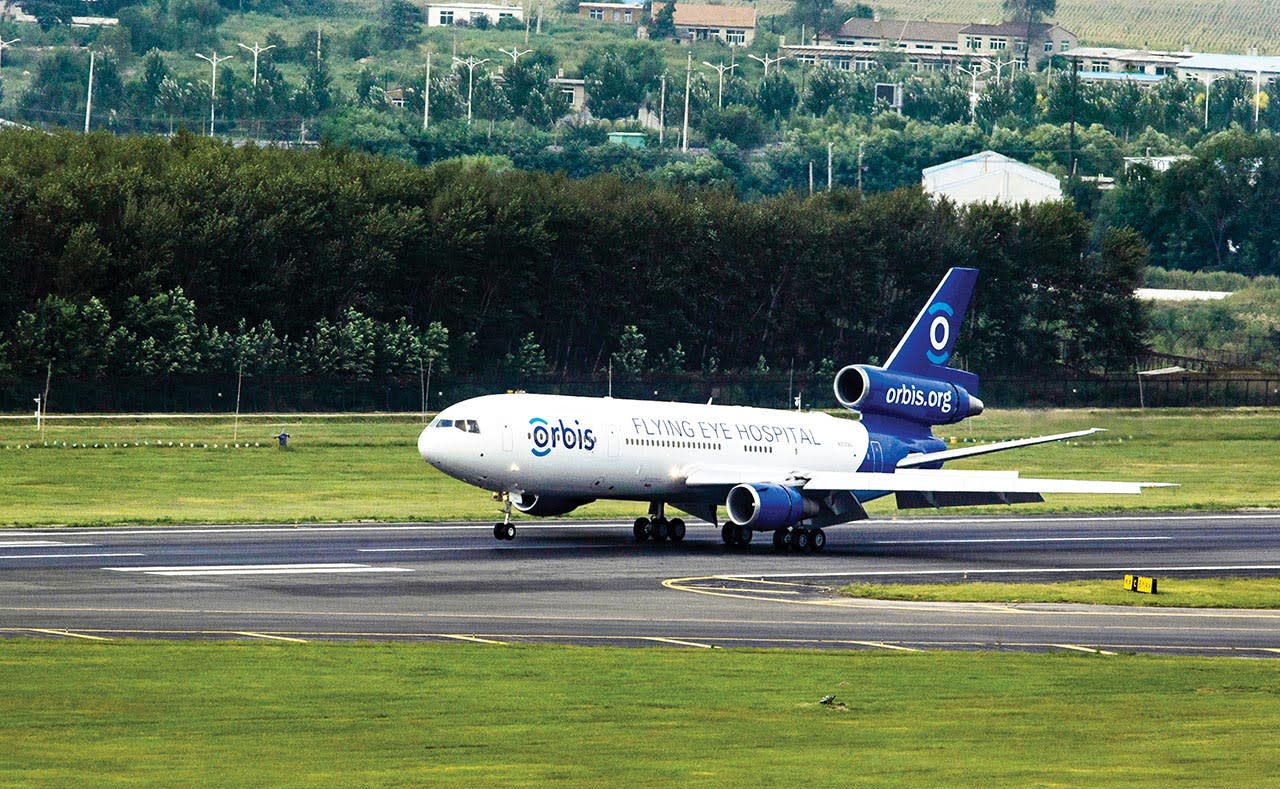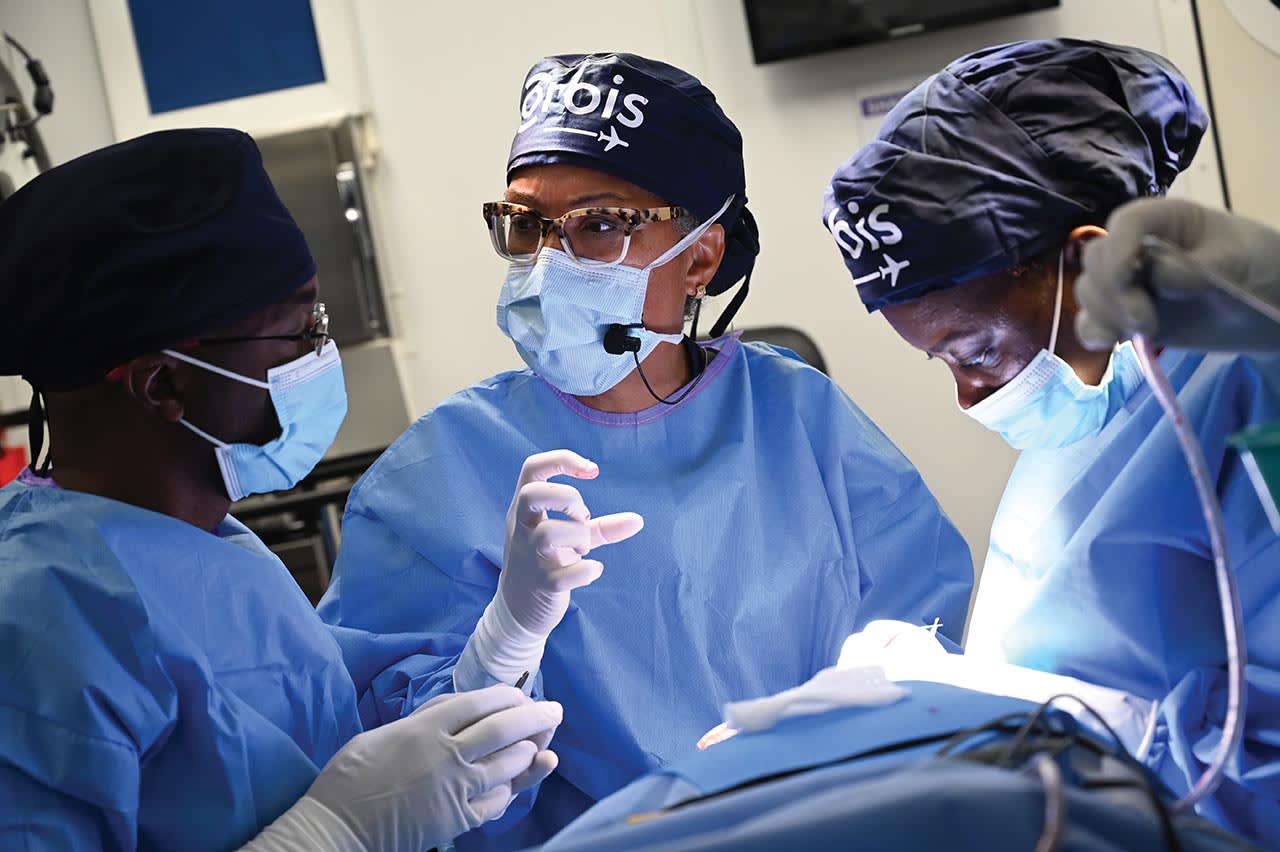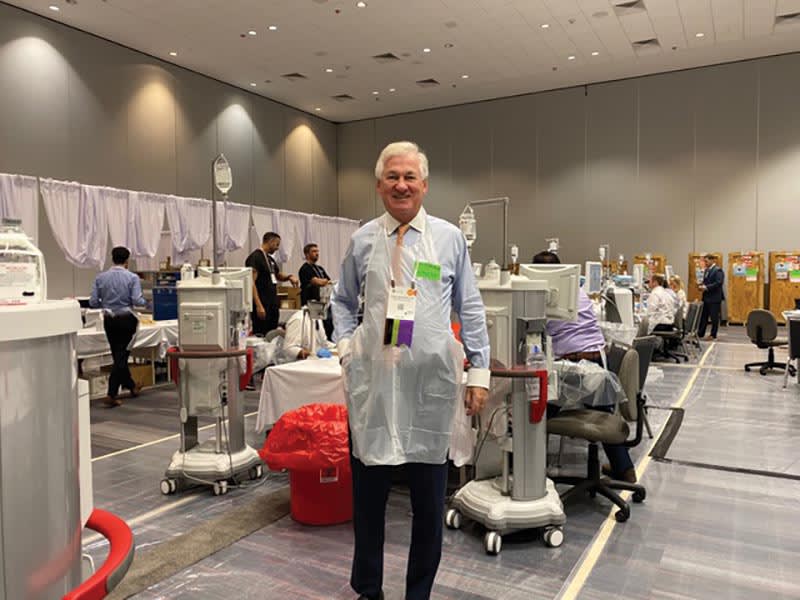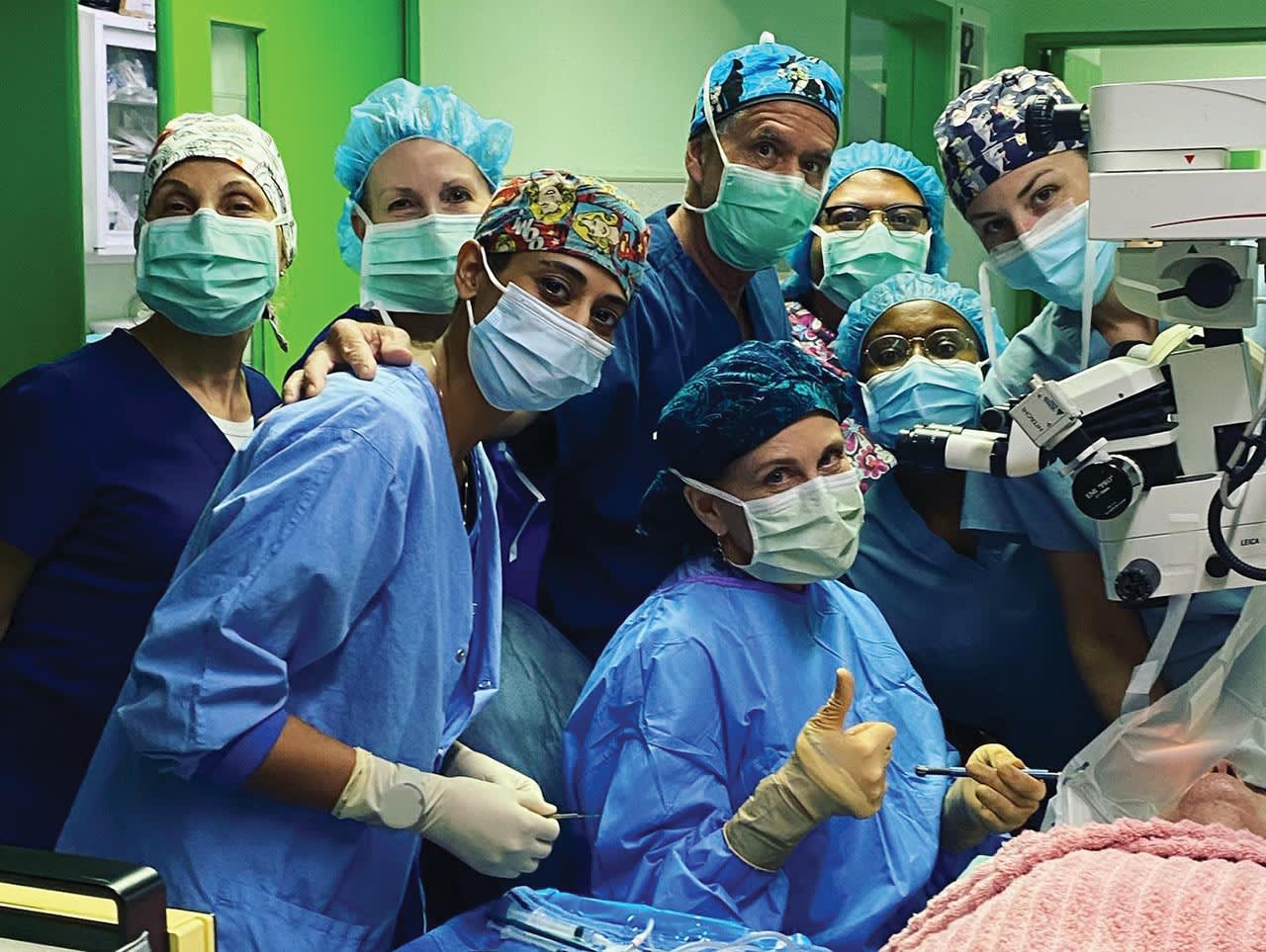In a world where access to high-quality health care remains uneven, ocular surgery stands out as a critical but often overlooked need. Millions of people in low-income and middle-income countries (LMICs) grapple with visual impairments such as deep-seated white cataracts, glaucoma, and ocular tumors, with little opportunity to receive effective treatment for their conditions.
In 2020, an estimated 596 million people worldwide had distance vision impairment, including 43 million who were blind. Another 510 million people had uncorrected near vision impairment, simply because of not having reading spectacles.1 Cataract, the leading cause of blindness and the second-leading cause of moderate and severe visual impairment globally, affects more than 100 million people, 17 million of whom are blind.2
An estimated 90% of these people live in LMICs in Asia, Africa, and Latin America,1,2 where access to ocular surgery is often restricted by poor awareness of services, as well as limited numbers of surgeons and eyecare facilities. Despite the enormity of this challenge, a growing community of ocular surgeons in the United States has taken meaningful steps to help alleviate some of these eye health issues around the world.
Orbis International
One organization stepping up to make a difference is Orbis International, a global nonprofit that provides sight-saving programs in more than 200 countries. Among the most notable of these is the organization’s Flying Eye Hospital, which serves as a mobile teaching hospital, ensuring that local eyecare teams in LMICs receive hands-on training while working alongside Orbis’s volunteer faculty of ophthalmic surgeons and other eyecare professionals.
“We’re a fully Quad A-accredited hospital,” says Lori Pacheco, a former volunteer nurse on the Flying Eye Hospital who now serves as the associate director of volunteer experience and engagement for Orbis. In her current position, she recruits ocular surgeons from around the country to volunteer with Orbis.
The airplane itself, a converted MD-10 cargo jet donated by FedEx in 2016, comprises a classroom, a fully outfitted surgical suite with preoperative and recovery rooms, a laser room, and a state-of-the-art mobile simulation center. During a project, team members provide training in their subspecialties—such as cataract, glaucoma, cornea, retina, or oculoplastics—and treat both children and adults.
“I was able to volunteer on the Flying Eye Hospital last year in Zambia and participate in retina and pediatric glaucoma procedures on the plane,” Pacheco says, adding that dozens of people are needed to complete a successful project. Orbis provides air operations and mechanical teams as well as key logistic and administrative personnel, and engages the help of volunteer pilots for the Flying Eye Hospital, as well as volunteer surgeons, nurses, biomedical engineers, and anesthesiologists.
“That’s one of the reasons why I like Orbis so much, because it takes a whole team to perform a successful eye surgery,” Pacheco says. “It’s not just doctors teaching doctors. We’re training nurses. We’re training anesthesiologists. We’re training biomedical engineers. We’re training ophthalmic technicians. It’s a team approach.”
Orbis International also operates long-term programs in Asia, Africa, and Latin America. Working with local partners, the organization trains eye-health professionals in their own hospitals. “We send volunteers to train [eyecare teams], just without the plane,” Pacheco says. “We just had a very successful program in Hawassa, Ethiopia, and it was a team [consisting of] an ophthalmologist, an orthoptist, an anesthesiologist, and a nurse.”
In Cyberspace
Orbis also engages volunteer eye care professionals on Cybersight, an online platform that offers free virtual access to ophthalmic training resources developed by international medical experts. Offerings range from courses, webinars, and lectures to live surgical demonstrations, remote surgical mentorship, advice on complex patient cases, and even an AI diagnostic tool. According to Orbis, more than 90,000 eyecare professionals in more than 200 countries and regions are registered on the platform. This allows world-class experts to provide their expertise and have a meaningful impact in many corners of the globe without leaving their homes.
“The platform allows us to extend clinical training far beyond the areas where we run programs or where the Flying Eye Hospital touches down,” Pacheco explains. “We even have people in conflict-affected areas, like Ukraine and Syria, who are logging on and getting trained.”
The Right to Sight and Health
Another organization with a mission similar to Orbis International’s is the Right to Sight and Health. Cofounded by Donald Macdonald, MD, of the Monmouth Eye Center in New Jersey, and Judith Simon, MD, who heads the eye unit at a hospital in northern Ghana, the Right to Sight and Health is a nonprofit dedicated to treating cataract patients and educating ocular surgeons in the developing world. The Right to Sight and Health focuses on treating patients with severely advanced cataracts through a technique called small incision cataract extraction. At the same time, it teaches local surgeons how to perform the procedure, which can be completed in less than 15 minutes.
“It’s a matter of getting the nucleus out, and then irrigating and putting an implant in and [leaving behind] a self-sealing wound. It can be done very quickly and efficiently without a lot of [the equipment] you’ll see here in the United States,” says Dr. Macdonald. He has organized more than 30 medical and surgical missions to Ghana, Senegal, Rwanda, Tanzania, Cameroon, the Philippines, and Nicaragua. Unlike many larger organizations, the Right to Sight and Health focuses on reaching small, remote communities with few or no ophthalmologists—mainly in Ghana, the organization’s base of operations.
Although he now focuses his efforts on fundraising for the organization, Dr. Macdonald still has vivid recollections of the reactions of patients once they could see clearly again.
“The typical patient was one who was nearly blind when we would bring them in for surgery in the afternoon,” he says. “We actually used a patch and shield because the surgery is more invasive than here in America. They take the patch off the next morning, and they’re so joyous that they can see again. It’s a reaction you don’t get that often in America.”
Relief Organizations
There are many other organizations that conduct ocular surgery mission trips. A few include Medical Ministry International, HCP Cureblindness, and the Hawaiian Eye Foundation. Cathleen McCabe, MD, recently returned from a medical mission trip to Migori, Kenya, with Kenya Relief. There, she and some 30 fellow volunteer ocular surgeons and support staff performed more than 100 surgeries and saw some 600 patients in clinic over the course of one week.
“The scope of problems that we see in Kenya is pretty advanced. We’ve seen really advanced traumas, advanced melanomas of the conjunctiva, even advanced tumors, and all the cataracts are blinding cataracts—dense, no-view white cataracts in little, tiny orbits that are very challenging,” says Dr. McCabe, chief medical officer of Eye Health America and medical director of The Eye Associates, both in Sarasota, Florida. Dr. McCabe adds that the environment—far removed from the typical American community—adds to the challenge. About 80% of households, she says, use firewood as their primary energy source, and the homes are mostly simple, mud-brick structures.
“It’s a challenging experience as a surgeon because it tests your flexibility and ingenuity. You don't always have all the tricks and special equipment that we have in the United States to deal with these cases, so you really must think about what is needed to help the patient, how you can do it safely, and how the patient is going to be able to care for themselves afterward,” she observes.
Dr. McCabe has also spent the past two decades serving alongside her longtime friend and colleague Eric Purdy, MD, in Saint Vincent and the Grenadines. Dr. Purdy is a board-certified ophthalmologist at Lutheran Health Physicians in Bluffton, Indiana.
Describing their efforts in Saint Vincent and the Grenadines as a mission “we’ve kind of poured our hearts into,” she says they have focused primarily on treating cataract patients but also operate an optometric and general ophthalmology clinic. “When we first started, there were no ophthalmologists in Saint Vincent taking care of indigent patients. Now there are four ophthalmologists that we work with. Three of them are general ophthalmologists and one is a retina specialist,” Dr. McCabe says. She adds that she and Dr. Purdy travel to the country once each year for a week-long stay, during which they will treat about 1,000 patients. During their last visit, she says, they distributed 700 pairs of eyeglasses collected by the local Lions Club.
Like Dr. Macdonald, Dr. McCabe says she harbors many memories of her experiences treating patients in Kenya and Saint Vincent and the Grenadines.
“I like to tell the story of this lady I saw in Saint Vincent who was bilaterally blind and was not able to ambulate or do any of her activities of daily living,” she says. Accompanied by her daughter, the woman came to have a cataract removed.
“When the daughter came back another time with her mom to have the other eye done, she was so grateful,” Dr. McCabe recalls. “She said, ‘you don't know how my life has changed. Before, I had to get up really early, I had to make sure my mom was OK for the day, take care of my toddler and make sure she was going to be okay, drop her off at daycare, work, come home, take care of my mom, and take care of my daughter. Now, my mom takes care of herself, and she can help me with my daughter. My life is completely changed.’ It brought the perspective that what we do is not always just for the patient; it's often meaningful for the family. What we do has a ripple effect.”
To read more about Dr. McCabe’s experiences in Kenya and Saint Vincent, click here.
But the memories are also sometimes bittersweet. Dr. McCabe recalls a 4-year-old boy who had been poked in the eye with a stick and presented with a “huge scleral perforation” that had become infected. “He needed to be enucleated, but that was probably a life-saving treatment for him, because where was he going to go to get that treatment? And how accessible was it going to be when they waited a month for him to see us? Can you imagine the pain he was in for that entire month?”
A “Noble Cause” that Helps Patient and Physician
Surgeons who put their skills to work for those in underserved communities around the world encourage their colleagues to do the same, not just for the patients’ benefit but also for their own.
“People are in great need all over the world, and we’re just a small drop in the bucket going over to help,” says Dr. Macdonald. “But it’s a noble cause and, just as we help people in our own country, we need to help them, too. That’s our job as physicians.”
“I highly encourage people to go,” agrees Dr. McCabe, who believes that volunteering on a medical mission trip overseas can help “make you a better surgeon.”
“I’ve brought back so many different tips that I use in my daily clinic and in surgery based on things I had to think about differently and different tools I had to use on a mission because I didn’t have everything available to me. It will benefit you in ways that you can't imagine now, and your patients also will benefit from it,” she says. OASC
References
1. Jolley E, Virendrakumar B, Pente V, Baldwin M, Mailu E, Schmidt E. Evidence on cataract in low- and middle-income countries: an updated review of reviews using the evidence gap maps approach. Int Health. 2022;14(Suppl 1):i68-i83. doi:10.1093/inthealth/ihab072
2. Burton MJ, Ramke J, Marques AP, et al. The Lancet Global Health Commission on Global Eye Health: vision beyond 2020. Lancet Glob Health. 2021;9(4):e489-e551. doi:10.1016/S2214-109X(20)30488-5












